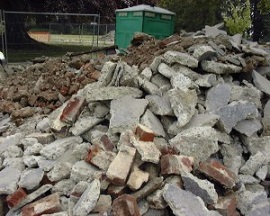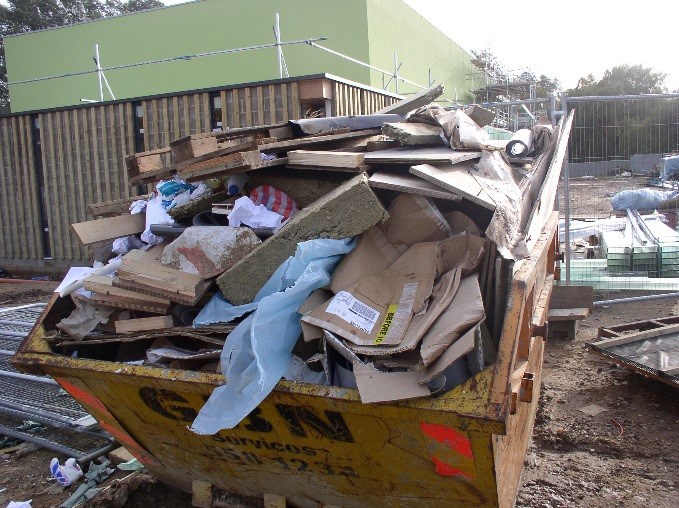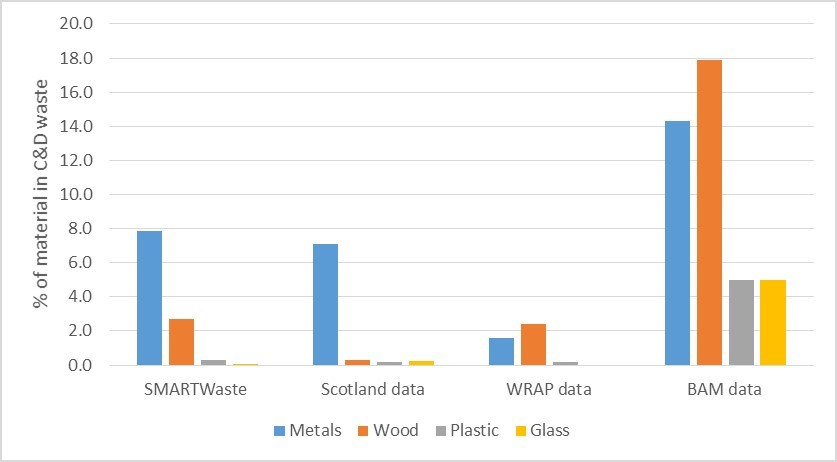Improving construction and demolition waste data
[edit] Introduction
Specialists in construction and demolition (C&D) waste at BRE, undertook a study to assess the shape of information regarding C&D waste in the UK. This is part of the work the BRE Trust is doing to help 'building a better world together'.
A summary of the study is provided below, and the full study is available by contacting the SmartWaste team at BRE.
[edit] A study of UK construction and demolition waste data
Data on C&D waste is used in different ways by different stakeholders – from setting targets for individual projects, to providing information to report against EU targets.
However, a recent report by the RWM Ambassadors highlighted the significant gaps and weaknesses in C&D waste data. The BRE study is intended to improve the C&D waste data used by DEFRA to report against EU targets.
Waste data reports have been developed over a number of years by DEFRA, but some areas are based on assumptions that may be outdated or where better data may now be available.
Two main areas for reporting against European targets were highlighted, and their various sources of data assessed.
[edit] Recycled aggregate and internally recycled materials estimates
To calculate the amount of C&D waste produced, information from the Environment Agency about waste managed at treatment facilities is used.
However, this does not include recycled aggregate or soils produced and dealt with on site (known as ‘under an exemption’). This is estimated from the Minerals Products Association (MPA) data from 2008 which is adjusted annually based on construction industry value. This review aimed to supplement this useful information with additional, more recent data.
The table below shows various sources of information – highlighting the benefits and issues associated with each.
| DATA SOURCE | INFORMATION | DATA | BENEFITS | ISSUES |
| Mineral Products Association | Estimate of amount of recycled aggregate from C&D activities | 45.3 million tonnes of recycled aggregate produced in 2012 in UK. Estimated that 38.9 million tonnes for England | Ongoing data so would allow for comparison with previous years | Based on data from 2008 and updated based on construction output Source of information used to estimate construction output no clear |
| UEPG (European Aggregates Associate) | Estimate of amount of recycled aggregate produced | 44 Million tonnes of recycled aggregate produced in UK in 2012 | Not additional data as based on MPA data | |
| National Federation of Demolition Contractors | Estimate of percentage of inert demolition waste that is reused or recycled onsite | 54.4% of inert demolition waste produced is reused or recycled onsite in UK | Produced annually Based on member information | For demolition only Breakdown for England not currently available |
| SmartWaste (related to aggregates) | Estimate of the percentage of inert CD&E waste that is reused or recycled onsite | 32.5% of inert CD&E waste is reused or recycled onsite |
Can be broken down into construction, demolition and excavation phases Can be updated regularly Based on SmartWaste members waste arisings data |
Data limited to users of SmartWaste Some companies who use SmartWaste do not record onsite reuse of materials |
| SmartWaste (related to soils) | Estimate of the % of soil produced that is reused or recycled onsite | 50.8% of soils produced are reused or recycled onsite |
Can be broken down into construction, demolition and excavation phases Can be updated regularly Based on SmartWaste members waste arisings data |
Some companies do not record onsite reuse of materials |
[edit] Currently there is no way to know the breakdown of materials in C&D waste
As with home recycling, when mixed waste goes through a sorting facility, many different types of waste from different sources are combined. Once this mixed waste is sorted, it is not known how much of the segregated materials come from each source.
In the construction industry, knowing the proportions and quantities of individual materials in mixed waste can help both individual companies and the sector as a whole to identify issues and set targets.
Various data sources were reviewed around this issue, showing a significant difference in the breakdowns produced from each.
In particular, the WRAP (Waste Resources Action Programme) data suggests there are very low proportions of metal, timber, plastic and glass; whereas company specific data (from a review of a variety of organisations’ CSR reporting) indicates much higher proportions of these materials.
[edit] September RWM discussion panel
The issue of availability and weaknesses of C&D data was recently discussed at RWM, where Stuart Blofeld from SmartWaste took part in a panel discussion.
The main points from this session were that:
- The construction sector is quite good at collecting data but that more use could be made of it to effect real change on construction and demolition sites.
- Ongoing discussions with various (construction professionals, waste management professionals and government agencies), should continue to ensure progress is made in collecting reliable, useful data.
- Ongoing analysis of SmartWaste data could help provide information for the industry, helping set targets for waste reduction and improved materials management.
[edit] How can this situation be improved?
Data from NFDC and SmartWaste could be used alongside MPA information to allow improved estimates of internally recycled materials – resulting in a better understanding of how these materials are managed, enabling government and key construction stakeholders to develop and improve on this.
The data contained within SmartWaste could be used alongside more information from individual companies to provide an estimate of material breakdowns – this will help construction companies identify materials to target for waste reduction.
This article was originally published here by BRE Buzz on 17 Jan 2017. It was written by Maggie Blackwell.
--BRE Buzz
[edit] Related articles on Designing Buildings Wiki
- BRE Buzz articles on Designing Buildings Wiki.
- BRE SMARTWaste John Muir release.
- Circular economy.
- Design for deconstruction – helping construction unlock the benefits of the circular economy.
- How data can stop waste.
- Landfill tax.
- National Federation of Demolition Contractors NFDC.
- Recyclable construction materials.
- Site Waste Management Plan.
- SiteSmart.
- SMARTWaste.
Featured articles and news
RTPI leader to become new CIOB Chief Executive Officer
Dr Victoria Hills MRTPI, FICE to take over after Caroline Gumble’s departure.
Social and affordable housing, a long term plan for delivery
The “Delivering a Decade of Renewal for Social and Affordable Housing” strategy sets out future path.
A change to adoptive architecture
Effects of global weather warming on architectural detailing, material choice and human interaction.
The proposed publicly owned and backed subsidiary of Homes England, to facilitate new homes.
How big is the problem and what can we do to mitigate the effects?
Overheating guidance and tools for building designers
A number of cool guides to help with the heat.
The UK's Modern Industrial Strategy: A 10 year plan
Previous consultation criticism, current key elements and general support with some persisting reservations.
Building Safety Regulator reforms
New roles, new staff and a new fast track service pave the way for a single construction regulator.
Architectural Technologist CPDs and Communications
CIAT CPD… and how you can do it!
Cooling centres and cool spaces
Managing extreme heat in cities by directing the public to places for heat stress relief and water sources.
Winter gardens: A brief history and warm variations
Extending the season with glass in different forms and terms.
Restoring Great Yarmouth's Winter Gardens
Transforming one of the least sustainable constructions imaginable.
Construction Skills Mission Board launch sector drive
Newly formed government and industry collaboration set strategy for recruiting an additional 100,000 construction workers a year.
New Architects Code comes into effect in September 2025
ARB Architects Code of Conduct and Practice available with ongoing consultation regarding guidance.
Welsh Skills Body (Medr) launches ambitious plan
The new skills body brings together funding and regulation of tertiary education and research for the devolved nation.
Paul Gandy FCIOB announced as next CIOB President
Former Tilbury Douglas CEO takes helm.
UK Infrastructure: A 10 Year Strategy. In brief with reactions
With the National Infrastructure and Service Transformation Authority (NISTA).


























